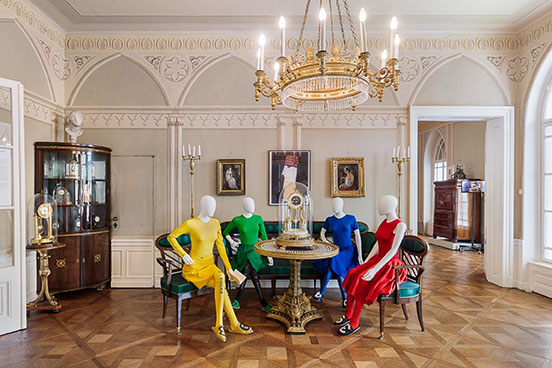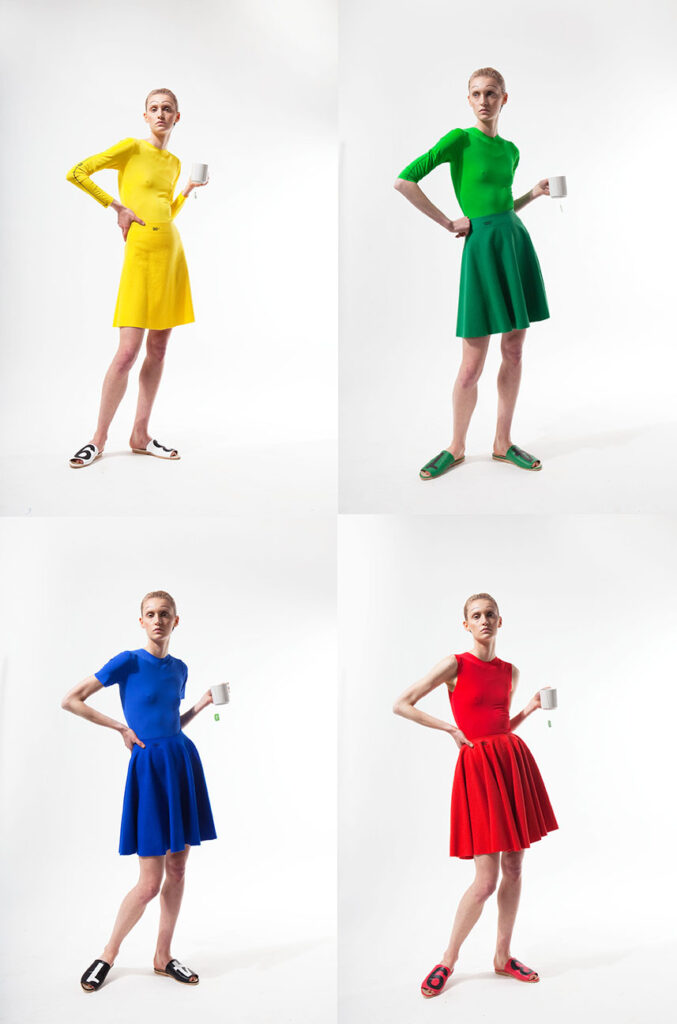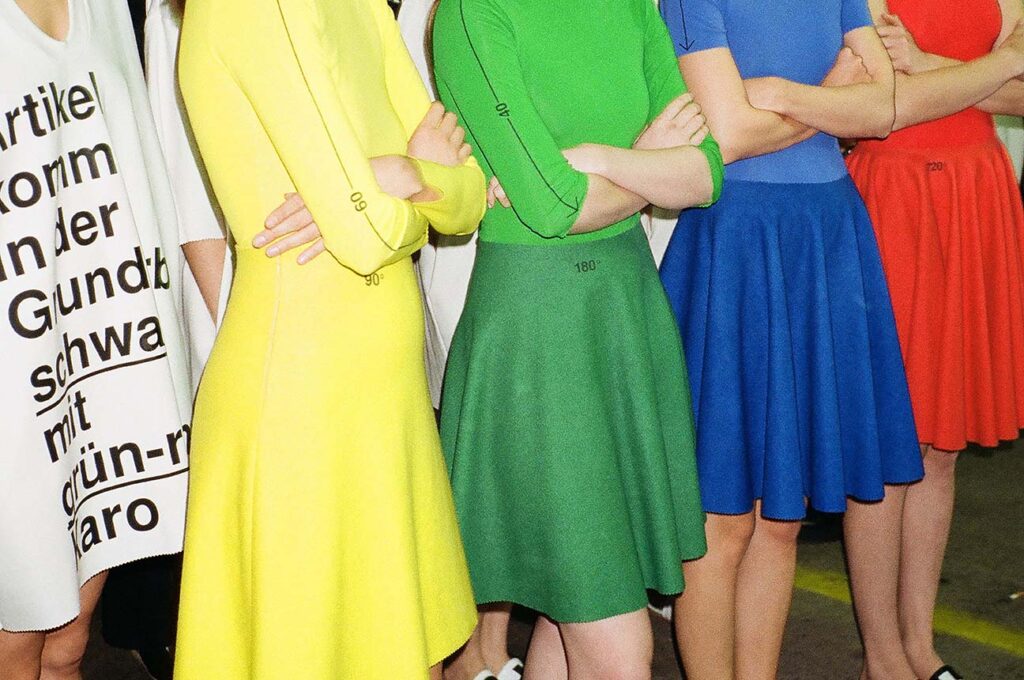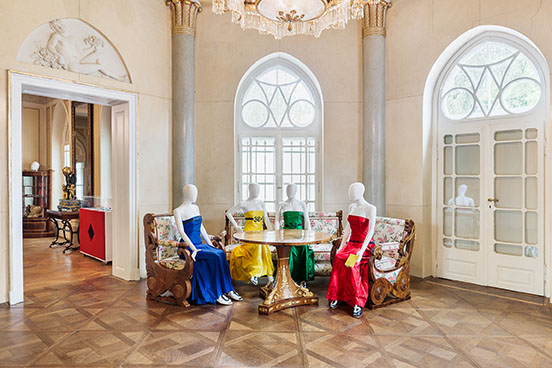12. Mai 2023
Anna-Sophie Berger: Fashion is Fast
As a part of the series (CON)TEMPORARY FASHION SHOWCASE Anna-Sophie Berger’s exhibition The Years will be on display at MAK Geymüllerschlössel from May 13. At the occasion of The Years in the historic interior of the Geymüllerschlössel she stages fashion – e.g. garments from her graduation collection Fashion is Fast (2013), as well as objects and artworks from the collections of the MAK or the Theatermuseum Vienna. Matthew Linde, fashion exhibition-maker and researcher gives an introduction on the Fashion is Fast collection for the MAK Blog.
„In some places, it is fixt and certain; as all over Asia, and in Spain; but in France, England, and other places, the Dress alters; Fashion or the alteration of Dress, is a great Promoter of Trade, because it occasions the Expence of Cloaths, before the Old ones are worn out: It is the Spirit and Life of Trade; It makes a Circulation, and gives a Value by Turns, to all sorts of Commodities; keeps the great Body of Trade in Motion; it is an Invention to Dress a Man, as if he lived in a perpetual Spring; he never sees the Autum of his Cloaths.“ Nicholas Barbon (in, Discourse of Trades, The Lord Baltimore Press, 1690, 32)

MAK Exhibition View, 2023
(CON)TEMPORARY FASHION SHOWCASE: Anna-Sophie Berger. The Years
Anna-Sophie Berger, collection Fashion is Fast, 2013
MAK Geymüllerschlössel
© kunst-dokumentation.com/MAK
For her 2013 graduate collection, titled Fashion is Fast, Anna-Sophie Berger’s work dealt with the organizational superstructure of fashion collections. Her collection comprised a series of basic block garments, such as skirts with bodices, jeans, suits with scarves, jumpers with sweatpants and rudimentary ballgowns. They were made in both primary RGB and CMYK colors, the two optimized modes for mixing color for digital and printed products respectively. Segments of the garments featured black, bold-printed numbers that corresponded to the altered measurements of its pattern block: the increased degrees of swing were recorded on skirts; the inches of bust, waist, and hip emblazoned on ballgowns; or shoe sizes printed across the entire face of pairs of slippers. Fashion is Fast was to reify the rhythmic “poiesis” of a collection, which is especially expected from a designer’s debut, as a series of austere, calculated measured variables. NATO phonetic alphabets were also printed vertically down the legs of pants and tights. Clothes as semiotic code systems.

Anna-Sophie Berger, four skirts from the collection Fashion is Fast, 2013
© Maria Ziegelböck
Fashion is fast—like an algorithm, which programs us accordingly. This phenomenon is most glaring today from the perspective of global supply chains and its titular fast fashion industry, in which the might of Asia has commandeered design reproduction and dispersal. The Shenzhen copy instantiates fashion’s speed to astonishing effect. It is no surprise that Shein, the Chinese online fast fashion retailer, was founded by a search engine optimization (SEO) specialist. Here, fashion’s microtrends are economically optimized for maximum consumption. However, fashion’s algorithmic fastness is not unique to the virtual 21st century. In the 1860s, Charles Frederick Worth introduced the signatory designer label into his couture gowns in an attempt to curb the mercenaries of design piracy. He failed miserably, as a global market for ready-to-wear styles mimicking Parisian couture proliferated. By the 1910s, couturiers were signing off on cheaper diffusion lines for American manufacturers. Design “originality” was paradoxically guaranteed by its industrial reproduction. It was the copy, not the original, that fueled the financial and aesthetic engines of modern Western dress.

Anna-Sophie Berger, collection Fashion is Fast, backstage, 2013
© Milica Balubdžić
Even before couture’s industrial innovation of fashion, the dynamics of rapid copying and perpetual recycling pervaded discourses on fashion. Nearly 100 years before Worth’s label, Rose Bertin, the personal modiste to Marie Antoinette, captured this spirit in her declaration, “There is nothing new except what has been forgotten,” suggesting an almost postmodernist conception of fashion, which has accelerated so rapidly that it has already reached the finish line. In the 1670s, the first fashion magazines can read eerily similar to TikTok videos on contemporary microtrends in their reportage on the latest, fleeting details in bonnets or hem brocades. The English economist and financial speculator Nicholas Barbon of the same period praised the mystery of fashion’s capricious change, as he understood, like Shein today, how it was the great promoter of trade. This is all to say, fashion is not authored by us, but rather authors us, as a kind of proto-algorithm that emerges from the outside.

MAK Exhibition View, 2023
(CON)TEMPORARY FASHION SHOWCASE: Anna-Sophie Berger. The Years
Anna-Sophie Berger, collection Fashion is Fast, 2013
MAK Geymüllerschlössel
© kunst-dokumentation.com/MAK
That this dynamic can be vivified in Berger’s methodological collection is a testament to both the algorithm and the artist.
Posted by Matthew Linde, fashion exhibition-maker and researcher




